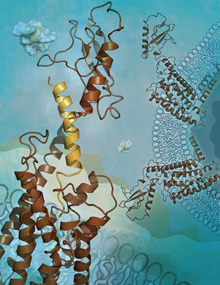Structure of a Potential Diabetes Drug Target
Structure of a Potential Diabetes Drug Target
Researchers have determined and analyzed the structure of the human glucagon receptor. The findings may aid in the development of drugs for type 1 and type 2 diabetes and other metabolic disorders.
When blood glucose levels rise, such as after a meal, your pancreas releases the hormone insulin. This stimulates muscle, fat and liver cells to take up glucose from your blood. Conversely, when blood glucose levels drop, such as after an overnight fast, the pancreas releases the hormone glucagon, which stimulates liver and muscle cells to release glucose into the bloodstream. In healthy people, blood glucose levels are maintained within a tight range through these and other mechanisms.

Structure of the human glucagon receptor. /Image by Katya Kadyshevskaya, courtesy of Scripps Research Institute.
People with diabetes, though, have difficulty using glucose, and their blood glucose can rise to dangerous levels. Medications such as insulin and glucagon can help maintain blood glucose in a safe range.
Glucagon works by binding to a G-protein coupled receptor (GPCR). GPCRs span cell membranes and relay signals from the outside in. Once activated by the binding of a substance, the receptor triggers a cascade of responses inside the cell. These receptors help control many essential cell functions and so are an important target for drugs.
GPCRs are subdivided into classes A, B and C. The structures of several class A receptors have already been uncovered. However, the structures of class B receptors, including the glucagon receptor, have largely remained unsolved because of technical difficulties.
An international team, led by Drs. Fai Yiu Siu and Raymond C. Stevens of Scripps Research Institute, set out to determine the structure of the glucagon receptor. Their study was funded in part by NIH’s National Institute of General Medical Sciences (NIGMS) and National Institute of Diabetes and Digestive and Kidney Diseases (NIDDK). Results appeared in the July 25, 2013, issue of Nature along with research from a British group that reported the structure of another class B receptor, corticotropin-releasing factor receptor type 1.
The scientists, who have extensive experience working with receptors, used a “fusion protein” to painstakingly create crystals of the glucagon receptor so that the structure could be determined by X-ray crystallography. In addition, they altered more than 100 different amino acids in the receptor protein to better understand what parts of the receptor help bind the hormone. They then built a structural model of the receptor with glucagon bound to it in order to predict how the hormone and receptor interact.
Their work revealed that, typical of GPCRs, the receptor has 7 membrane-spanning sections. It differs from class A GPCRs, however, in that it has a wider and deeper pocket for glucagon to bind. It also has a “stalk” region that extends outward from the cell membrane. The researchers believe this stalk helps the receptor capture the hormone and position it to fit snugly into the receptor’s main binding pocket.
“Our data should change the current view of how drugs are designed with this and related receptors,” Siu says. “If you’re trying to get a drug molecule to fit snugly into that pocket, you might need a larger one than those that are normally used to target class A GPCRs.”
The team is now working to determine the exact structure of the receptor when glucagon is bound to it.
By Carol Torgan, Ph.D.
###
* The above story is reprinted from materials provided by National Institutes of Health (NIH)
** The National Institutes of Health (NIH) , a part of the U.S. Department of Health and Human Services, is the nation’s medical research agency—making important discoveries that improve health and save lives. The National Institutes of Health is made up of 27 different components called Institutes and Centers. Each has its own specific research agenda. All but three of these components receive their funding directly from Congress, and administrate their own budgets.



















